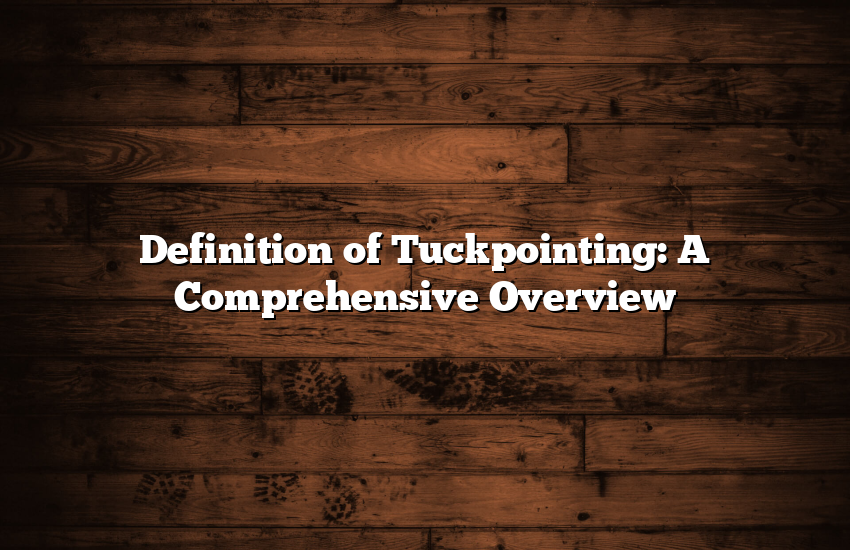
The Definition of Tuckpointing: Tuckpointing, a term often heard but not always understood, plays a crucial role in the maintenance and aesthetic enhancement of brick buildings. This process, involving the renewal of mortar joints in masonry construction, is not just about preserving the structural integrity of buildings but also about enhancing their visual appeal.
Table of Contents
The Essence of Tuckpointing
Tuckpointing, at its core, involves the careful removal of deteriorated mortar from the joints between bricks and the subsequent insertion of new mortar. This new mortar ideally matches the brickwork’s original color, maintaining the uniformity and historical appearance of the building.
Historical Significance of Tuckpointing
In the late 18th century, England developed tuckpointing as a method to initially imitate high-quality rubbed brickwork at a lower cost. Over time, the technique evolved, and its practical benefits in preserving masonry became apparent.
Why Tuckpointing Matters
Protecting Your Investment
The main functional purpose of tuckpointing is to prevent water and moisture from entering the brickwork. Water ingress can cause significant damage, including the weakening of the structure, mold growth, and interior damage. By maintaining the mortar joints, tuckpointing effectively safeguards the building against these issues.
Aesthetic Enhancement
Apart from its practical benefits, tuckpointing also revives the building’s appearance, restoring its original charm and character. This is particularly important for historical structures where maintaining architectural integrity is crucial.
Tuckpointing Process Explained
The process of tuckpointing involves several key steps:
- Inspection and Assessment: Before any work begins, a thorough inspection is conducted to assess the extent of mortar deterioration.
- Removal of Old Mortar: Specialized tools are used to carefully remove the old, damaged mortar without harming the bricks.
- Preparing and Applying New Mortar: A new mortar mix, matched to the original color, is prepared and carefully applied into the joints.
- Finishing Touches: After the mortar is applied, it’s shaped and smoothed to match the original joint profile.
Tuckpointing Definition: A Closer Look
Understanding the tuckpointing definition involves recognizing its role in both preservation and aesthetics. It’s not just a maintenance task; it’s a craft that requires skill and precision.
Distinguishing Tuckpointing from Repointing
It’s important to distinguish tuckpointing from repointing. While both involve working with mortar joints, repointing is simply the process of renewing mortar joints, whereas tuckpointing also involves applying a fine line (or “tuck”) in a contrasting color in the center of the mortar joints to create a neat, artificial impression of well-formed bricks.
Tuckpointing: A Necessity for Brick Structures
Regular tuckpointing is essential for the longevity and appearance of brick structures. It prevents structural damage, maintains property value, and keeps buildings looking their best.
Conclusion
This comprehensive guide on the definition of tuckpointing aims to provide homeowners in the USA with an easy-to-understand yet detailed insight into this essential maintenance practice. Understanding and implementing proper tuckpointing techniques is crucial for the longevity and beauty of brick structures.
FAQs About Tuckpointing
Q: What is the definition of tuckpointing?
A: Tuckpointing is the process of renewing the mortar joints in brick masonry to prevent decay and enhance appearance.
Q: How frequently should one perform tuckpointing?
A: Inspect tuckpointing every 25-30 years or as needed; the timeframe may vary, but it is a general guideline.
Q: Can I do tuckpointing myself?
A: While it’s possible, tuckpointing is a skilled craft. Professionals often achieve the best results, so it’s advisable to leave it to them.
Q: What are the signs that my building needs tuckpointing?
A: Look for crumbling or missing mortar, moisture damage, or a change in the texture of the mortar joints.
Q: Is tuckpointing expensive?
A: The cost depends on the extent of the work needed. However, it’s a valuable investment in maintaining your property.


